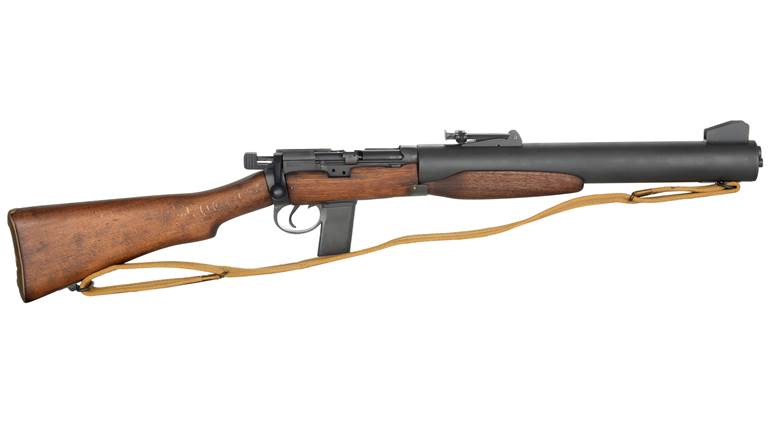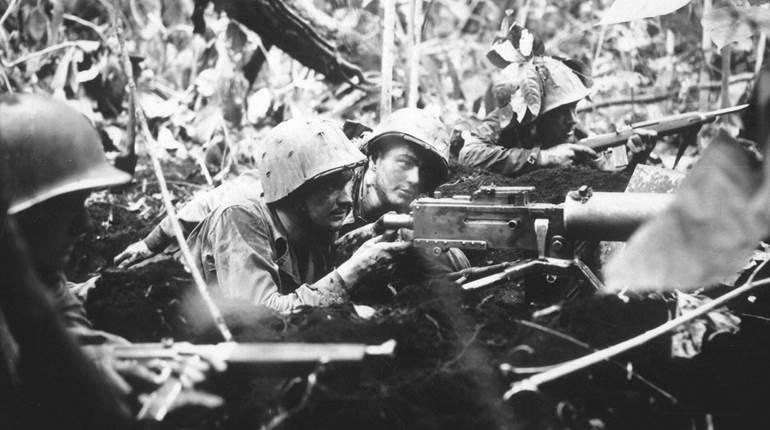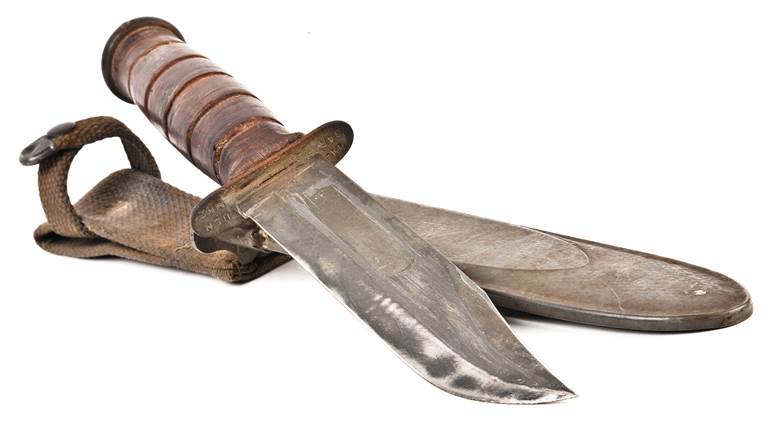
Lieutenant Colonel Simon Fraser, the 15th Lord Lovat, brandishes his swagger stick while briefing No. 4 Commando before the Boulogne Raid. David Style is seen on the left of the photograph with a modified SMLE slung on his shoulder and a Colt M1911 on his hip.
Simon “Shimi” Fraser, the 15th Lord Lovat (the 17th de facto), was one of the most brilliant tacticians Britain produced during World War II. A fine gentleman, a superb soldier and a commando leader, Lovat was once referred to by Winston Churchill as “the mildest-mannered man that ever scuttled a ship or cut a throat.”
As a lieutenant colonel leading No. 4 Commando, he planned and implemented the only truly successful facet of the ill-fated raid-in-force on Dieppe on Aug. 19, 1942. The entire operation was codenamed “Jubilee,” though his commando’s role of the action was referred to as “Cauldron.” His unit was tasked with the elimination of the Hess shore artillery battery at Varengeville-sur-mer, three miles west of Dieppe, which it performed with spectacular aplomb.
Two years later, on D-Day, Lord Lovat was the brigadier general commanding the 1st Special Service Brigade, composed of the Nos. 3, 4 and 6 commandos, the Free French Commando, and No. 45 Royal Marine Commando. Dug-in near Le Plein, these elite soldiers were able to withstand—and defeat—massed German counter-attacks of three times their strength on their section of front during the night of June 10, 1944.
This was the decisive battle of the perimeter, and only through Fraser’s enlightened tactical know-how and the determination of the Commandos and 6th Airborne troops, did the eastern flank of Overlord remained intact. Two days later, on the night of June 12, Brig. Gen. Fraser was severely wounded by friendly artillery fire and evacuated. His wounds precluded him from any further active service, though he remained in the reserves until 1962 as a brigadier.

Simon Fraser had grown up on an immense Scottish estate surrounding the ancestral residence of the Chiefs of Clan Fraser, Beaufort Castle on the Beauly River near Inverness. From an early age, he enjoyed a vigorous outdoor life of fishing and hunting. Stalking red deer over the wild terrain taught him the importance of fine marksmanship and fitness. Following his appointment as commanding officer of No. 4 Commando in April 1942, these early lessons on movement over a rugged landscape and stalking were just two of the many he incorporated into the training of his Commando. Lovat’s memoir March Past made clear that he knew in tactics, as in hunting, when to be cautious in an advance, where to dig-in and when to charge; he said of the latter, “Get off the beach and you will live.”
The expectation that an officer was to provide his personal sidearms had by World War II been a long-standing tradition in the British army. Also, an essential part of a commando’s training was to be familiar with a variety of arms and understand their operation, those of both the Allies and the Axis troops.
So much latitude was given to the arms shouldered by Commando officers that, for example, Lt. (later Capt.) David Style appears in an Imperial War Museum (IWM) image attending a briefing by their new commanding officer immediately before No. 4 Commando’s Boulogne raid (Operation Abercrombie) with a modified SMLE and a Colt M1911 in a modified Pattern 1937 web holster. For all intents and purposes, this altered Lee-Enfield depicts the rifle that a backwoods deer hunter would have made from a surplus Lee-Enfield in the 1960s, when SMLEs were then cheap and cheerful.
However, I can attest that this type of rifle handles superbly without the extra weight of the fore-end, and is surprisingly accurate to at least 250 yds. Later on in the Commandos, this fashion of “personalized” arms gave way to more standardized arms, as more choices from the coming abundance of better British and U.S. guns from Lend-Lease made their appearances.

Dieppe
Looking first at the earlier Dieppe era, the belief that Lt. Col. Fraser was armed with a Winchester sporting rifle is purported to have arisen from an interview by a newspaper reporter on No. 4 Commando’s return to England. Subsequently, many authors have perpetuated this identification as dogma.
However, from close examination of several IWM photos taken by Lt. Humphrey Spender at the Newhaven docks after No. 4 Commando disembarked following the raid, the rifle Lovat carried appears to be a Model 1892 Steyr-Mannlicher sporter, likely in 6.5x53 mm [rimmed], that used en bloc clips for loading. Thus, Fraser did field a sporting rifle, but not the one that has been repeated so often in print. It was one that he’d grown up with hunting, with the Lord Lovat saying, “It was a rifle I had done a lot of shooting with, and I was dead accurate with it.”
One photograph of Fraser with rifle slung clearly shows a loaded clip tucked into where his rear webbing brace is affixed to the waist belt. Attempting to clarify this particular arrangement, the IWM image was replicated and enlarged. While its provenance is not unequivocal, the takedown Steyr-Mannlicher pictured is likely the rifle Lovat carried on Aug. 19, 1942.
This rifle was found on the grounds of Beaufort Castle and brought to my attention by a long-time friend of the Fraser family in 2006 when it sold at a Holt’s UK auction, along with other firearms previously owned by the late Lord Lovat. What now appears as virtually unequivocal is that Fraser was armed with a clip-loading Steyr sporting rifle when he and his No. 4 Commando destroyed the Hess battery during the Dieppe raid.
Nimble and light, Steyr Models 1892 and 1893 were exceedingly popular stalking rifles in the British Isles from the turn of the 20th century and throughout the interwar years. From that early period the London gunmaker W.J. Jeffery & Co. converted Dutch and Romanian surplus rifles and sold a multitude of these to hunters in both England and America. One such was purchased by the environmentalist-hunter Charles Sheldon, who defined the initial boundaries of Alaska’s Denali National Park.
The 6.5 mm round is exceedingly accurate and perfect for medium-size game. Subsequently, many of these Steyr models saw extensive use in back-position match shooting. Re-barreled many times over throughout the decades for competition, from 6.5 mm to .303 British, then to .303 Magnum, and again to 7.62x51 mm NATO in the 1960s, this turn-of-the- century rifle has shown both its flexibility and its inherent ability for robustness and precision. It is little wonder then why Lord Lovat chose to carry such a useful rifle with which he was so familiar.

D-Day
The Allied invasion of continental Europe, D-Day, June 6, 1944, has been immortalized in numerous films, as it should, with possibly the most noteworthy being producer Darryl F. Zanuck’s 1962 epic rendition of author Cornelius Ryan’s history The Longest Day. Filmmakers have traditionally used extreme artistic license at times when producing a “historical” movie, combining multiple personalities into a single character and dwelling on popular dogma that may not be entirely accurate.
Brigadier Fraser was an adviser to “The Longest Day,” and also with him was Maj. John Howard who, on the night of June 5, 1944, had led the glider-borne coup de main assault on the vital Pegasus Bridge spanning the Orne Canal. Howard’s Oxfordshire and Buckinghamshire (Ox & Bucks) Light infantry were the first Allied troops with “boots on the ground” in Normandy. In the film, Maj. Howard was portrayed by Richard Todd, who had fought in Normandy with the British 6th Airborne.
While I find Howard’s depiction in the movie quite believable, as it is acted out by a person who had “been there,” the portrayal of the brigadier, by actor Peter Lawford, though likely truthful in heroics and personality, have always struck me as highly influenced from nostalgic memories of the Commando esprit de corps with regard to his “uniform” and arms. Still it was a great film!
Lawford wore a white, roll-necked pullover sweater, and was armed with a full-stocked Steyr Mannlicher sporting carbine, the rifle possibly harkening back to fond recollections of the Steyr in the Dieppe raid. Again from March Past, on p. 320, Lord Lovat indicates that he carried quite a different rifle.
On his advance from Sword Beach to Pegasus Bridge to meet Maj. Howard’s 6th Airborne, his commandos encountered an enemy platoon of about 30 advancing across a field of standing corn with the sun in their eyes, the author wrote, “I made the quick decision to ambush them. It was a relief to get the rucksack off—straps were already burning shoulders—then tee up behind its bulk and go into action with a light, short-barrelled U.S. carbine.” Later on, too, Lovat mentions that, on D-Day, he swapped the carbine for a rifle because the former “did not get the distance” to wound a suspected collaborator, at 400 yds., hiding at the corner of a cow pasture.

Further supporting evidence can be seen in IWM film stills of a D-Day-produced film showing Brigadier Fraser passing in front of the cinematographer shouldering an M1 carbine where both its distinctive butt (with side-mounted sling) and front sight on its barrel, are conspicuous. Also notable is the complete absence of a white, roll-necked pullover sweater, instead, the brigadier wears a more discrete, and much less obvious to German snipers, khaki battledress jacket.
These images were from a film taken by Sgt. N. Clague of the Army Film and Photography Unit (who was killed on June 9 filming a night attack) at 1st Special Service Brigade’s HQ in Amfréville, just east of the Orne bridgehead. Interestingly, the white pullover Lawford wore might not be totally fictional, and may play a part in some fond memories of Lord Lovat’s commandos. There is a June 5 image with Fraser in the foreground, on an LCI/L (Landing Craft Infantry, Large) mid-channel, wearing what appears to be a light-colored sweater. I’m certain that the Channel crossing was cold and the sweater was necessary.
It’s hardly surprising that Brigadier Fraser carried a U.S.-manufactured arm. At that stage in the war the abundance of U.S. firearms is reflected by their conspicuous usage among British and Commonwealth troops in all theaters. Colt Government Models (M1911s) in .45 ACP and Thompson submachine guns had always been favored from the early days of the war, obtained initially through the British Purchasing Commission and later, after March 1941, through Lend-Lease, but possibly no more so than by the Commandos and the Airborne, before the latter traded-in their Tommy Guns for Stens in 1942.
Additionally, as self-loading M1 rifles and carbines became plentiful their allure and prospect of increased firepower compared to a revolver or bolt-action rifle must have been very tempting to an officer. Canadian author Farley Mowat in his wartime autobiography And No Birds Sang, as a young lieutenant during the invasion of Sicily, upon meeting a group of U.S. Airborne, exchanged his .38/200 S&W revolver (“about as useful in modern warfare as an arquebus”) for an M1 carbine, stating, “This weapon was something the like of which none of us had ever seen before, and its possession subsequently made me an object of much envy.”
M1 Garand rifles as well were envied by the commandos, ever since their first introduction to them when 50 U.S. Army Rangers accompanied Nos. 3 and 4 commandos on the Dieppe raid. To substantiate this, in another still from Sgt. Clague’s D-Day filming, No. 6 Commando’s commander, Lt. Col. Derek Mills-Roberts, has his M1 Garand slung while examining a map held by 6th Airborne’s intelligence officer Maj. Gerald Lacoste.
In a time when the visual media, film and Internet have such overwhelming impacts on our collective beliefs of what may have happened in a previous era, we should not be satisfied with simply taking what is portrayed, but to dig just a little deeper. These findings from archives are pieces to a never-ending puzzle about events that none of us have experienced firsthand, and may have only heard today from our parents, an uncle or aunt or our grandparents.
Memories of wartime events and heroics should be preserved no matter what inaccuracies in recollections may prevail, since our “Greatest Generation” kept this world free from the fascists in Germany and Italy and the militarists of Japan, thus a lot of latitude can be accepted in these memories. For those of us involved in the writing of histories about those troubled times, however, we need to be accurate in our interpretations and seek out the facts, no matter where these obscure details may now reside.






































